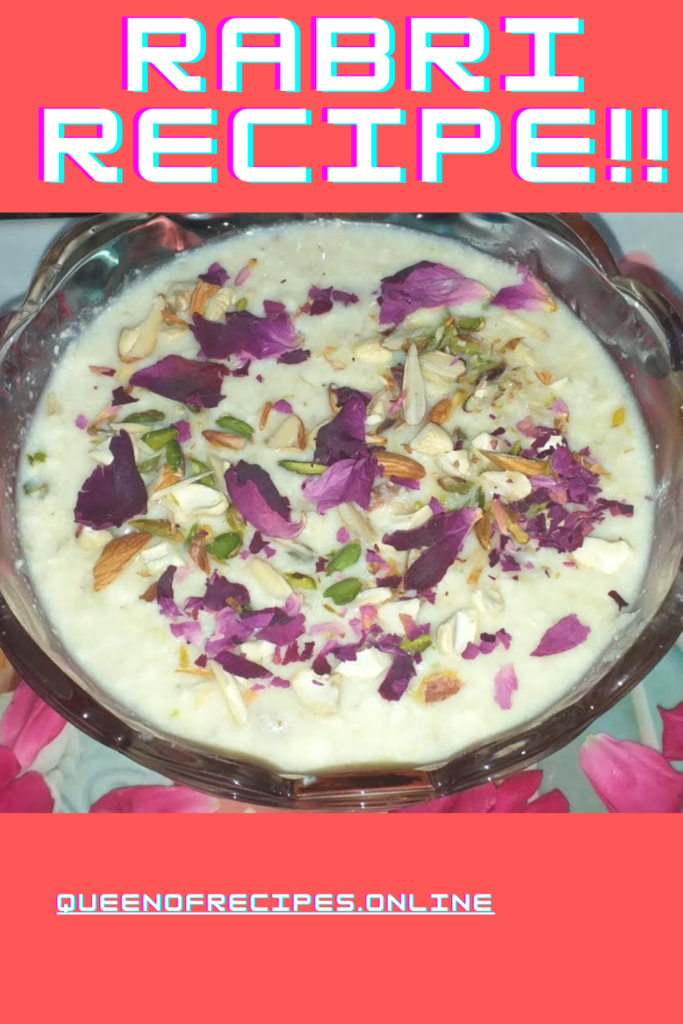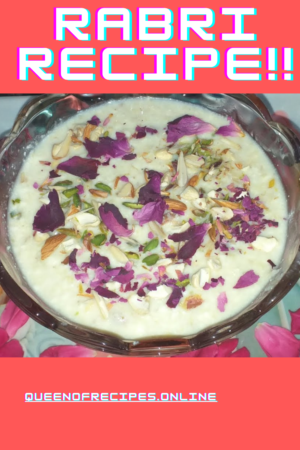Table of Contents
About Rabri.
Rabri, also spelled as “Rabdi,” is a traditional Indian dessert known for its rich and creamy texture. This indulgent sweet dish is popular in North India and is made by simmering milk over low heat until it thickens and reduces significantly. During this slow-cooking process, the milk develops a deep, caramelized flavor and takes on a luscious, creamy consistency. It is typically flavored with cardamom and garnished with chopped nuts like almonds and pistachios. It can be served warm or chilled and is often enjoyed on special occasions and festivals as a delightful and decadent treat.
Here’s how to make Rabri, a rich and creamy Indian dessert, at home:
Ingredients:
- 1 liter full-fat milk
- 1/2 cup sugar (adjust to taste)
- 1/2 teaspoon cardamom powder
- A pinch of saffron strands (optional)
- 1 tablespoon chopped nuts (almonds, pistachios)
- 1/2 teaspoon rose water (optional)
Instructions:
- Prep the Milk:
- Pour the milk into a heavy-bottomed pan and place it over low heat. Use a wide and deep pan to allow for evaporation.
- Simmer and Reduce:
- Let the milk simmer over low heat, stirring occasionally to prevent it from sticking to the bottom. As the milk begins to heat up, a layer of cream will form on the surface. Gently push this cream layer back into the milk.
- Add Saffron (Optional):
- If you’re using saffron strands, soak them in a tablespoon of warm milk for a few minutes. Then add this saffron-infused milk to the simmering milk. This will impart a beautiful color and aroma to it.
- Continue Cooking:
- Continue to simmer the milk for about 1.5 to 2 hours or until it reduces to approximately half its original quantity. Stir occasionally to avoid sticking.
- Add Sugar and Cardamom:
- Once the milk has reduced, add sugar and cardamom powder. Mix well and continue to simmer for another 10-15 minutes, or until the sugar dissolves completely and the Rabri thickens further.
- Garnish and Flavor:
- Add chopped nuts and rose water (if using) to it. Stir to combine.
- Cool and Serve:
- Allow it to cool to room temperature. You can serve it warm or chilled, depending on your preference.
- Chill (Optional):
- For a chilled it refrigerate it for a few hours before serving.
- Serve:
- Garnish with more chopped nuts and saffron strands, if desired, and enjoy your homemade Rabri.
Rabri is a delightful dessert with its creamy texture and sweet, aromatic flavor. It’s often served in small portions due to its richness and makes for a wonderful treat on special occasions or as a sweet ending to a traditional Indian meal.


Nutritional Value.
The nutritional value of it (per 100 grams) can vary based on factors like the recipe and the specific ingredients used. Here’s an approximate breakdown of the nutritional content of traditional Rabri:
- Calories: Approximately 290-330 calories
- Carbohydrates: Approximately 25-30 grams
- Protein: Approximately 5-7 grams
- Fat: Approximately 18-20 grams
- Saturated Fat: Approximately 11-12 grams
- Cholesterol: Approximately 60-70 milligrams
- Sugar: Approximately 20-25 grams
- Calcium: Approximately 150-200 milligrams
- Phosphorus: Approximately 100-120 milligrams
Please note that these values are approximate and can vary depending on the specific recipe, the ratio of milk solids to sugar, and any additional ingredients or garnishes used. It is a rich and indulgent dessert, primarily made from milk and sugar, which contribute to its calorie and fat content. It is typically enjoyed in moderation due to its richness.
Health Benefits.
While Rabri is a delicious and indulgent dessert, it’s important to note that it is a high-calorie and high-fat treat primarily made from milk and sugar. Therefore, it should be enjoyed in moderation. However, it does offer some nutritional benefits:
- Calcium: It is a good source of calcium, thanks to the use of milk as its primary ingredient. Calcium is essential for strong bones and teeth, and it also plays a role in various bodily functions.
- Protein: Milk used in it provides protein, which is necessary for tissue repair and muscle development.
- Energy: It is calorie-dense, making it a quick source of energy. It can be a good option for individuals who need to boost their calorie intake.
- Satiety: Due to its richness and sweetness, it can be satisfying in small portions, which may help control cravings for other sweets.
- Occasional Treat: While it’s not a health food, it can be a delightful treat on special occasions or as an occasional indulgence.
It’s important to consume it in moderation, especially if you are watching your calorie and sugar intake. Its high sugar and fat content can contribute to weight gain and other health issues if consumed excessively. Additionally, individuals with lactose intolerance or dairy allergies should exercise caution when consuming it.
Tips and Tricks.
Making it is a traditional process that requires patience and attention to detail to achieve the desired creamy texture and rich flavor. Here are some tips and tricks to help you make delicious Rabri:
- Use Full-Fat Milk: Opt for full-fat milk, as it yields a creamier and richer it. Skim or low-fat milk won’t give you the same results.
- Wide and Heavy Pan: Use a wide and heavy-bottomed pan or kadai to prevent the milk from sticking to the bottom and ensure even evaporation.
- Constant Stirring: Initially, stir the milk occasionally to prevent it from sticking. As it starts to thicken, stir more frequently to avoid burning.
- Cream Layer: Push the cream layer that forms on the surface back into the milk. This contributes to the richness of it.
- Saffron Infusion: If using saffron for flavor and color, soak the saffron strands in a tablespoon of warm milk for a few minutes before adding them to it.
- Low Heat: Keep the heat low throughout the cooking process to allow for gradual evaporation and caramelization of the milk.
- Patience: Making it is a slow process. It may take 1.5 to 2 hours or even longer to achieve the desired thickness and flavor. Be patient; the result is worth it.
- Adjust Sugar: Adjust the amount of sugar to your taste. Some prefer Rabri to be sweeter, while others prefer it less sweet.
- Flavor Variations: Experiment with flavorings like cardamom, rose water, or a pinch of nutmeg to customize the taste to your liking.
- Chill Before Serving: For a chilled it, allow it to cool to room temperature and then refrigerate it for a few hours before serving. This enhances its flavor and texture.
- Garnish: Garnish with chopped nuts like almonds and pistachios for added texture and visual appeal.
- Serve in Small Portions: It is rich, so serve it in small portions to savor its flavor without overindulging.
Remember that making it is a labor of love, and the final result is a decadent dessert worth the effort. Adjust the sweetness, flavors, and garnishes to suit your preferences, and enjoy this delightful Indian treat.


Serving Suggestions.
Rabri is a creamy and indulgent Indian dessert that can be served in various ways. Here are some serving suggestions:
- Serve Chilled: It can be served chilled, making it a refreshing dessert, especially during hot weather.
- Garnish: Garnish with chopped nuts like almonds, pistachios, and slivers of silver or gold leaf for an elegant presentation.
- Saffron: Top with a few strands of saffron soaked in warm milk to enhance its flavor and add a beautiful golden hue.
- Rose Water: A drop or two of rose water can be added for a subtle floral aroma and taste.
- Fruit: Serve it with fresh fruits like strawberries, mangoes, or pomegranate seeds for a fruity twist.
- Falooda: Create a Rabri Falooda by layering it with falooda (vermicelli), soaked basil seeds (sabja), and ice cream for a delightful dessert parfait.
- Rabri Jalebi: Pair it with crispy jalebis for a classic Indian dessert combination.
- Hot or Warm: While Rabri is often served chilled, some prefer it warm. You can gently heat it in a microwave or on the stovetop if you prefer it that way.
- Indian Festivals: Rabri is a popular sweet during Indian festivals like Diwali and Raksha Bandhan. It can be part of a traditional festival spread.
- Individual Servings: Present Rabri in individual serving bowls or cups for an elegant touch, especially when serving guests.
- Indian Thali: Include Rabri as one of the sweet components in an Indian thali (a traditional meal platter).
- Dessert Parfait: Create a dessert parfait by layering Rabri with crumbled cake or cookies and fruits, similar to a trifle.
Remember that Rabri is a rich and decadent dessert, so small portions are often sufficient to satisfy your sweet cravings. Customize your serving style based on your preferences and the occasion and enjoy this classic Indian treat.
FAQs.
What are the key ingredients in Rabri?




The key ingredients in Rabri, a traditional Indian dessert, are:
Full-Fat Milk: Rabri is primarily made from full-fat milk. The milk is simmered over low heat for an extended period, leading to the development of its creamy and rich texture.
Sugar: Sugar is added to sweeten the Rabri. The quantity of sugar can be adjusted to suit individual preferences for sweetness.
Cardamom: Ground cardamom or cardamom powder is often used to flavor Rabri, giving it a pleasant and aromatic taste.
Saffron (Optional): Saffron strands soaked in warm milk can be added for both color and a subtle floral aroma. This is an optional ingredient that enhances the dessert’s visual appeal and flavor.
What is Rabri’s texture and flavor like?



Rabri is known for its unique texture and flavor:
Texture: Rabri has a rich, creamy, and thick texture. It’s achieved through the slow and gradual reduction of milk. The milk solids thicken and create a luscious consistency that is slightly grainy due to the milk proteins.
Flavor: Rabri has a distinct flavor characterized by the deep caramelization of milk during the cooking process. It is delicately sweet, with a subtle hint of cardamom or saffron, depending on the flavorings used. The flavor is creamy, nutty, and mildly aromatic, making it a delightful and indulgent dessert.
How long does it take to make Rabri?




Making Rabri is a slow and patient process, and it can take approximately 1.5 to 2 hours or even longer, depending on the quantity of milk and the heat level used. The key is to simmer the milk over low heat to allow for gradual evaporation and caramelization, which gives Rabri its rich and creamy texture and distinctive flavor. While it may require time and attention, the end result is a delectable dessert well worth the effort.
Is Rabri the same as condensed milk or evaporated milk?



No, Rabri is not the same as condensed milk or evaporated milk. While all three involve the reduction of milk, they have distinct differences:
Rabri: Rabri is a traditional Indian dessert made by simmering full-fat milk over low heat until it thickens and reduces significantly. Sugar and flavorings like cardamom are added, and it has a creamy, slightly grainy texture and a sweet, caramelized milk flavor.
Condensed Milk: Condensed milk is milk that has been cooked with sugar until it becomes thick and syrupy. It is sweetened and used as a sweetener in various desserts and beverages. Condensed milk is much thicker and sweeter than Rabri.
Evaporated Milk: Evaporated milk is simply milk that has had about 60% of its water content removed through heating. It is unsweetened and has a thinner consistency than Rabri or condensed milk. It is often used as a milk substitute in recipes.
In summary, Rabri is a sweetened and flavored reduced milk dessert, while condensed milk is sweetened, and evaporated milk is unsweetened with reduced water content. Each serves different culinary purposes in various recipes.
Is Rabri gluten-free?




Yes, Rabri is naturally gluten-free, as it does not contain wheat or any gluten-containing ingredients. The primary ingredients in Rabri are full-fat milk, sugar, and flavorings like cardamom. Therefore, it can be enjoyed by individuals with gluten sensitivities or celiac disease without concerns about gluten-related reactions. However, it’s essential to ensure that no gluten cross-contamination occurs during the preparation process, especially when using utensils or ingredients that may have come into contact with gluten-containing foods.

